UNDERSTANDING TWELFTH NIGHT
The Holiday That Time Forgot
By Sandy Levins
 | |
 January 3, 2005
January 3, 2005
CAMDEN, N.J. -- Although its vestiges are still visible in the January 6 "Three Kings Day" celebration of Hispanic culture, the historic holiday of "Twelfth Night" has been abandoned and forgotten by almost all the rest of the country.

Photo: Hoag Levins
|
| The Twelfh Night cake was a central element of 18th-century celebrations. This one was on display in the 'Holiday Tastes and Traditions' exhibit at Winterthur Museum and Gardens. Larger photo.
|
The twelve-day, mid-winter festival Twelfth Night once ended with great public fanfare has receded to leave behind our truncated modern holiday season that views December 25 and January 1 as its high points, and January 2 as the day life goes back to normal.
18th century
But it wasn't always so for the people who inhabited the Delaware Valley and other parts of the colonies in the 18th century.
In recent years, the Camden County Historical Society, along with other historical research institutions like the Colonial Williamsburg Foundation and the Winterthur Museum and Gardens, has steadily shifted its view to acknowledge how very different today's Christmas traditions are from the past's.
In some ways, the historical record of 18th-century life portrays a Christmas far more drab and low-key than ours today. But in other ways, the same record illuminates a set of traditions -- including that of Twelfth Night -- that invoked the bonds of close community in a ways not matched by our own 21st century high-tech lifestyle.
Williamsburg and Philadelphia
The holiday celebrated as Twelfth Night in 18th-century American cities like Philadelphia and Williamsburg was a high-spirited mid-winter event whose practices date back to the days of ancient Rome.
It evolved from the Roman Saturnalia festival marking the onset of the winter solstice -- that point in late December when the sun, whose daily arc had reached its lowest, darkest, coldest point,
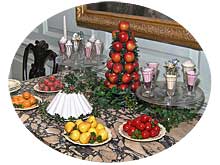
Photo: Hoag Levins
|
| The 18th century's Twelfth Night was a feasting holiday in an era where food presentation itself was a primary entertainment. Shown here is part of a typical spread of deserts that would have been seen in the mansions of the Delaware Valley. Larger photo.
| began its rise toward the longer, warmer days that would ultimately cause trees to bud and seeds to sprout in the spring.
Though originally rooted in pagan fertility rites, the annual practice of an extended winter solstice festival of feasting, family gatherings and public gaiety was later grafted into the emerging Christian culture of Europe. In the fourth century, in a move to placate those it hoped to convert and hold to the new faith, the Christian church pronounced the official date of the commemoration of Christ's birth to be that of the winter solstice: December 25th.
The Yule log
By the time of the late Renaissance, Christmas was a day of low-key observance that opened an annual twelve day festival of religious ceremony and secular celebration. The English word "Yuletide" actually means the twelve-day period between Dec. 25 and Jan. 6. In many communities, large bonfires were set in village centers and, on Christmas eve, each family burned a ceremonial Yule log to start the hearth fire around which its members and visitors would gather throughout the rest of the Christmas festival days.
While that period's most important holiday was New Year's, its second most important ended the twelve days on January 6 and was called Twelfth Night. Twelfth Night was a final frenzy of feasting, drinking and often-raucous merry making before the community returned to its daily working grind for the rest of the winter.
The spirit of that annual European custom which joyfully convulsed all society each year is captured in an extraordinary mid-17th century painting by David Teniers the Younger, a Flemish artist who specialized in documenting life among the common folk along Europe's western edge. Titled "Twelfth Night (The King Drinks)," the painting, now in the Prado Museum of Madrid, meticulously details a tavern scene on Jan. 6. Dancing, clowning and consuming prodigious quantities of liquor and food, the patrons are depicted as they follow the practice of crowning one of themselves "king" to rule over the Twelfth Night's
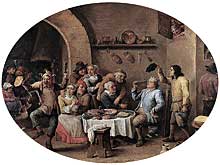
Prado Museum
|
| A 17th-century painting by David Teniers the Younger depicts a typical Twelfth Night celebration in a village tavern. Larger photo.
| festivities. Those who donned the crown were also expected to treat their fellow revelers to a round of drinks.
Twelfth Night cake
At some point, this tradition gave rise to the creation of the "Twelfth Night" cake -- an often-ornate confection into which a bean, a coin or a tiny carved or cast metal version of the Baby Jesus was placed. During early evening ceremonies, the cake was cut and its pieces distributed to guests who were advised to chew carefully. The person who found the icon then became the king or queen of Twelfth Night. By the late 18th century in England and America, the selection of Twelfth Night's "royalty" was also alternately accomplished by the distribution of paper slips with each piece of cake. The slips were opened and the person holding the one with a special mark inside was declared king.
Some believe this paper ballot tradition was instituted as a matter of safety to prevent often-inebriated and distracted guests from inadvertently choking to death on hard beans, coins or cast metal Jesuses hidden in wads of cake.
Wassail, the drink of good wishes and holiday cheer, has been associated with Twelfth Night since the 1400s. The ale-based drink seasoned with spices and honey was served in huge bowls, often made of silver or pewter. It was passed among family members and friends with the greeting "Wassail." The name comes from the old English term "Waes hael," meaning "be well."
Wassailing the apple trees
In England and Ireland, a related Twelfth Night drink called "Lambs Wool" was made of cider or ale, sugar, spices and roasted apples. It was customary to
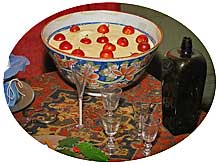
Photo: Hoag Levins
|
| Wassail bowls were central features in the homes of the rich as well as the poor during Twelfth Night. A symbol of hospitality and holiday good cheer, the ale-based drink was seasoned with spices and honey. Larger photo.
| ceremonially pour a little Lambs Wool or cider on your apple trees in order to bless them for a bountiful harvest in the coming year. The happy drink was applied to the trees with a "Wig," a triangular piece of toast floated in the Wassail bowl. The tradition was known as "wassailing the apple trees" and was likely to have been popular in the Delaware Valley where apple orchards were plentiful on 18th-century farms.
From its earliest days, the Twelve Days of Christmas festival involved masked dancers and play actors who cavorted through the streets and visited homes unannounced to beg for holiday treats and drink. In England they were called "Mummers," from the French term "momer," which means to wear a mask. Some historians suggest that when the Christian church initially subsumed the pagan Saturnalia, it may have encouraged or tolerated demonstrations by the newly faithful mocking the old Roman gods. Those early revelers donned grotesque masks satirizing the Roman deities but their masked street antics ultimately became a popular and unstoppable part of the Christian Christmas festival.
Village dancers and play actors
In the England and Ireland from which 17th- and 18th-century Delaware Valley colonists came, it was common for villagers to don costumes and face coverings to play music, dance and perform brief, impromptu Yuletide plays in the streets. Some blackened their faces with charcoal. Others wore suits made of thatched straw, transforming themselves into the village "straw man." Others masqueraded as animals. Several genres of English folk dancing, including Morris Dancing, Sword Dancing and Molly Dancing, evolved from this activity.
Meanwhile, in the castles and estate houses of society's upper crust, dancing remained an important part of the holiday in the form of formal balls.
The socially elegant level to which Twelfth Night celebrations rose in the high society of colonial America can be seen at the annual "Yuletides Past" museum displays that are now an annual Christmas season feature
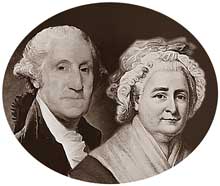
Images: National Archives
|
| George and Martha Washington were married in 1759 on Twelfth Night. The holiday that drew families together from long distances also provided a convenient venue for family weddings. Larger photo.
| at Winterthur Museum and Gardens in Winterthur, Del., as well as in the historic holiday tavern and home displays of Colonial Williamsburg in Virginia.
Washington's holidays
In fact, the 18th-century importance of Twelfth Night -- rather than Christmas Day -- is nowhere better documented than in the papers of George Washington. He paid scant attention to Christmas Day, usually attending a church service after which he would spend the day sorting through other year-end business matters of his plantation. Twelfth Night, however, was a different matter. Washington's records indicate that he and his wife Martha often entertained groups of relatives and friends throughout that day. Further illustrating how Twelfth Night holiday gatherings provided convenient opportunities for conducting other large family events, George and Martha Washington were married on Twelfth Night in 1759 in Williamsburg.
And Martha Washington's papers, preserved at Mt. Vernon, include her recipe for a huge Twelfth Night cake that included 40 eggs, four pounds of sugar and five pounds of dried fruits.
In the Delaware Valley, Christmas day was even less observed because the area was so heavily dominated by Quakers, who disdained ostentatious holiday behavior.
Grand Twelfth Night balls
However, throughout the region around Philadelphia, the nation's largest city, Twelfth Night was widely celebrated. In the homes of its wealthy non-Quaker merchants, gentlemen in powdered wigs and ladies in the finest silk gathered in mansion ballrooms to listen to chamber music, toast each other with crystal glasses and politely applaud the arrival of the magnificently decorated Twelfth Night Cake.
Other common Yuletide community activities included horse racing, fox hunting, cock fighting, card playing, apple-bobbing, blind man's bluff, nine-pins and other entertainments featuring mock sword fights, fiddlers, jesters, tight-rope walkers, plays and group singing.
Twelfth Night was also the time for each household to conduct its ceremonial extinguishing of the Yule log. Charred remains from the hearth were scooped up and kept for use in kindling the coming year's Yule log. Storing the Yule log remains in one's home also was thought to protect the house from fire and lightning.
Twelfth Night was a key feasting holiday in an era where food presentation itself was a primary entertainment. Affluent hostesses set tables with entres and desserts created and displayed
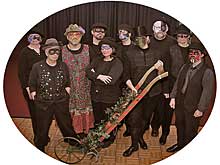
Photo: Hoag Levins
|
| In the Twelfth Night street 'frolics' that later evolved into the modern day Mummers' parade, villagers donned masks and costumes. Some dragged plows with them as they went house to house seeking holiday treats and drink. Today's Molly Dancer troupes like this one, continue the traditions in their performances. Larger photo.
| like sprawling works of edible art. The culinary exhibits were toured and touted like a gallery display before being consumed by the well-heeled guests.
Mummers frolic
Meanwhile, out in the streets of the Delaware Valley's cities and villages, it was a different scene as subsistence farmers, tradesmen and river workers carried out their annual "frolics," or street rites which tended to mix equal parts of merriment and mayhem in keeping with the old world traditions of holiday mummery.
In many ways, Twelfth Night and related Twelve Days customs were an annual catharsis of the community's social tensions, frustrations and anxieties. The public dancing, drinking and street foolery all openly and profusely mocked established authority and normal social controls. It was a time for letting loose that often caused its own kind of social friction.
One 18th century Pennsylvania patrician wrote that the local mummers "were a set of the lowest blackguards, who, disguised in filthy clothes and ofttimes with masked faces, went from house to house in large companies, ...obtruding themselves everywhere, particularly into the rooms occupied by parties of ladies and gentlemen, (and) would demean themselves with great insolence."
Molly dancers
Among the different street dancing traditions that came from the freezing, blustery peat bog regions of East Anglia in England was that of the "Molly" dancers. These all-male troupes would dress some of their members in women's clothing and move through the town dancing for handouts of money or beer.
The raucous street performing aspects of the Twelfth Night season were extremely popular throughout the Delaware Valley and evolved directly into what is today's Philadelphia's famous Mummers Parade. Another branch evolved into the modern day's New Orleans Mardi Gras.
It wasn't until the mid-1800s that American society broadly broke out of the twelve-day Yuletide tradition that so revered Twelfth Night as the grand culminating party of it all.
New Christmas traditions
During the first half of the 1800s, writers like Washington Irving, with his essays about what a perfect English Christmas should be; Clement Clark Moore, with his poem of a gift-giving St. Nicholas who climbs down the chimney; and Charles Dickens, with his brilliant "Christmas Carol" story, dramatically changed society's expectations of Christmas.
During the Civil War, famed illustrator Thomas Nast created the full-blown Santa Claus we know today. Meanwhile, the increasingly industrialized economy that rose out of that war fostered the concept of a Dec. 25 that pivoted around the buying and giving of consumer goods rather than the joys of dancing in the street or celebrating fellowship and good wishes with an ornate cake whose flavor, some said, lingered in the soul for the whole of the coming year.
~ ~ ~
Sandy Levins is a Trustee and director of programming at the Camden County Historical Society.
All Rights Reserved © 2005, Hoag Levins
HoagL@earthlink.net
About this Web site
| 








